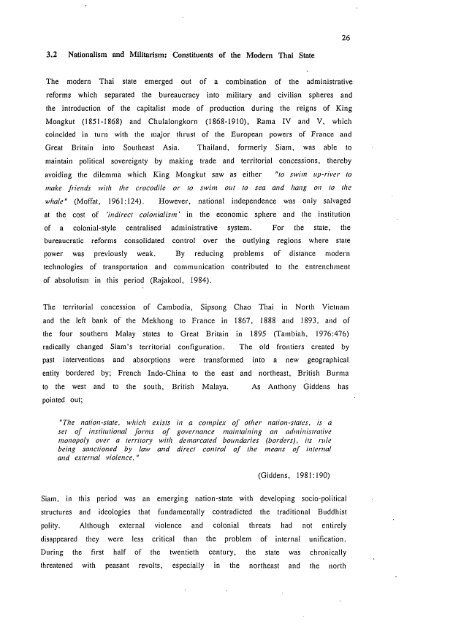iieiiei1eWrkers - Leicester Research Archive - University of Leicester
iieiiei1eWrkers - Leicester Research Archive - University of Leicester
iieiiei1eWrkers - Leicester Research Archive - University of Leicester
Create successful ePaper yourself
Turn your PDF publications into a flip-book with our unique Google optimized e-Paper software.
3.2 Nationalism and Militarism; Constituents <strong>of</strong> the Modem Thai State<br />
The modern Thai state emerged out <strong>of</strong> a combination <strong>of</strong> the administrative<br />
reforms which separated the bureaucracy into military and civilian spheres and<br />
the introduction <strong>of</strong> the capitalist mode <strong>of</strong> production during the reigns <strong>of</strong> King<br />
Mongkut (1851-1868) and Chulalongkorn (1868-1910), Rama IV and V, which<br />
coincided in turn with the major thrust <strong>of</strong> the European powers <strong>of</strong> France and<br />
Great Britain into Southeast Asia. Thailand, formerly Siam, was able to<br />
maintain political sovereignty by making trade and territorial concessions, thereby<br />
avoiding the dilemma which King Mongkut saw as either "to swim up-river to<br />
snake friends with the crocodile or to swim out to sea and hang on to the<br />
whale" (M<strong>of</strong>fat, 1961:124). However, national independence was only salvaged<br />
at the cost <strong>of</strong> 'indirect colonialism' in the economic sphere and the institution<br />
<strong>of</strong> a colonial-style centralised administrative system. For the state, the<br />
bureaucratic reforms consolidated control over the outlying regions where state<br />
power was previously weak. By reducing problems <strong>of</strong> distance modern<br />
technologies <strong>of</strong> transportation and communication contributed to the entrenchment<br />
<strong>of</strong> absolutism in this period (Rajakool, 1984).<br />
The territorial concession <strong>of</strong> Cambodia, Sipsong Chao Thai in North Vietnam<br />
and the left bank <strong>of</strong> the Mekhong to France in 1867, 1888 and 1893, and <strong>of</strong><br />
the four southern Malay states to Great Britain in 1895 (Tambiah, 1976:476)<br />
radically changed Siam's territorial configuration. The old frontiers created by<br />
past interventions and absorptions were transformed into a new geographical<br />
entity bordered by; French Indo-China to the east and northeast, British Burma<br />
to the west and to the south, British Malaya. As Anthony Giddens has<br />
pointed out;<br />
"The nation-slate, which exists in a complex <strong>of</strong> other nation-states, is a<br />
set <strong>of</strong> institutional forms <strong>of</strong> governance maintaining an ad,ninisiraiive<br />
monopoly over a territory with demarcated boundaries (borders), its rule<br />
being sanctioned by law and direct control <strong>of</strong> the ,neaiis <strong>of</strong> internal<br />
and external violence.<br />
(Giddens, 1981:190)<br />
Siam, in this period was an emerging nation-state with developing socio-political<br />
structures and ideologies that fundamentally contradicted the traditional Buddhist<br />
polity. Although external violence and colonial threats had not entirely<br />
disappeared they were less critical than the problem <strong>of</strong> internal unification.<br />
During the first half <strong>of</strong> the twentieth century, the state was chronically<br />
threatened with peasant revolts, especially in the northeast and the north<br />
26














